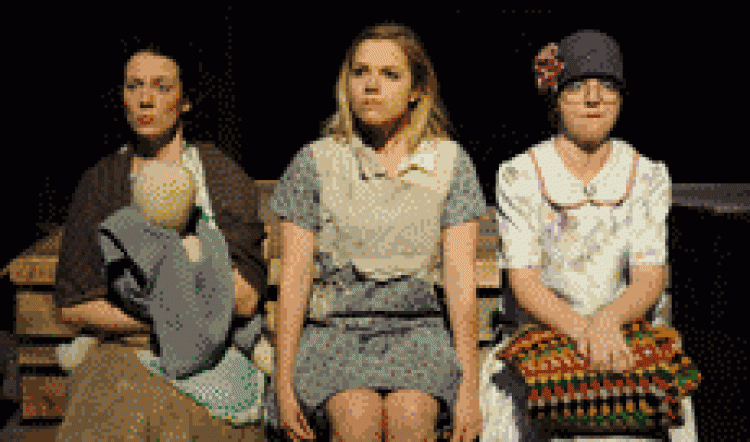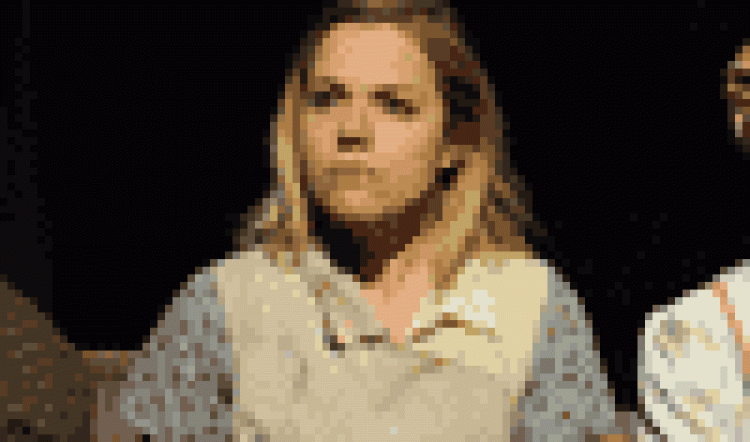
Thursday's Child
THURSDAY’S CHILD STC presents the Monkey Baa Theatre for Young People production at Wharf 2, November 9-13, 2009. Photography here by Heidrun Lohr.
SONYA HARTNETT is a multi-award winning novelist whose Thursday’s Child won the Guardian Children’s Fiction prize, the Aurealis Award for Best Novel in the Young Adult division in 2000; and was shortlisted for four others. Monkey Baa’s Sandra Eldridge, Eva Di Cesare and Tim McGarry adapted it for the stage and it has toured Australia successfully for the past six months and ends this particular odyssey with a short season at Wharf 2.
Set between WWs 1 and 2, Thursday’s Child (who has far to go) is Tin Flute, younger brother of Harper, Devon and Audrey. They live in a shanty on a worn out returned man’s selection somewhere unspecified. Mam and Da Flute struggle to feed and clothe their brood – others have lived and died aside from these survivors – and when the Crash of 1929 darkens the far horizon, the struggle becomes unequal and, finally, impossible.
Thursday’s Child exists on two levels of imagination; there is the “real” plane of the day-to-day lives of the Flute family and another – surreal – place inhabited by Tin who, in those days, would have been labelled simple. He “has a gift for digging” and does it obsessively. He starts with a hole beneath the family hovel and gradually disappears into the earth into a series of ever more extensive workings. That he becomes increasingly bonkers with each passing day and bit of tunnelling doesn’t seem to worry his family: there is much else to be concerned about. The divide between realism and surrealism is blurred and enhanced by Harper’s position as narrator and the audience’s link with the stories. Played by Janis McGavin with all the stoicism and innocence that a child so often displays in awful circumstances, Harper is the link between Tin’s netherworld and the harsh environs of drought, agricultural ineptitude, booze, predatory men and the Depression that is Flute family life.
For audiences – 14+ recommended – the play is 80 minutes of well-crafted storytelling and adaptation with solid performances across a range of roles by Charles Cousins (Devon and Mr Murphy), Belinda Hoare (Mam), James Lugton (Da), Brendon McDonall (Tin and Mr Cable) and Kate Worsley (Audrey and Mrs Murphy). Humour leavens the sadly authentic tragedy that dogs the Flutes and kids of all ages must love the concept of “the piddling chair”, as demonstrated by the aptly po-faced Mrs Murphy.

Hartnett’s novel has been compared (in the program notes at least) to English children’s author David Almond but for me, the recognition and similarity are with Tim Winton’s Cloudstreet. There is a poverty-stricken earth-bound family, a semi-detached “strange” son; and their studiedly picturesque names – Tin Flute/Fish Lamb etc. While Harper herself is reminscent of Harper Lee and To Kill a Mocking Bird where young Scout Finch and her brother Jem somehow survive their own gothic childhood. The twin strands of the denouement, however, are savagely satisfying and uniquely Thursday’s Child.
The adaptation, directed by Sandra Eldridge sustains the story, the pace and the drama and is absorbing and delightful in equal measure. An extensive and effective soundscape by Jeremy Silver segues through the action and adds to the visual and aural interest. The production is also well served by an economical and imaginative set (Imogen Ross) that effortlessly evokes the harsh environs of the selection as well as Tin’s subterranean world – in which lighting (Luiz Pampolha) plays a key role.
Although aimed at a youth audience, there is everything in Thursday’s Child for adults of all ages and it’s highly recommended.



